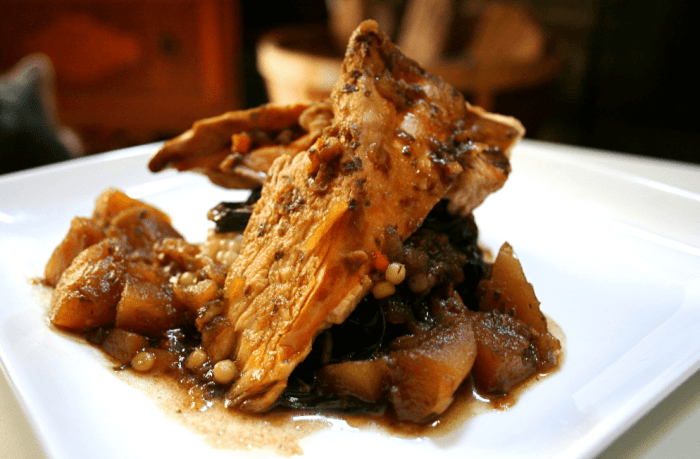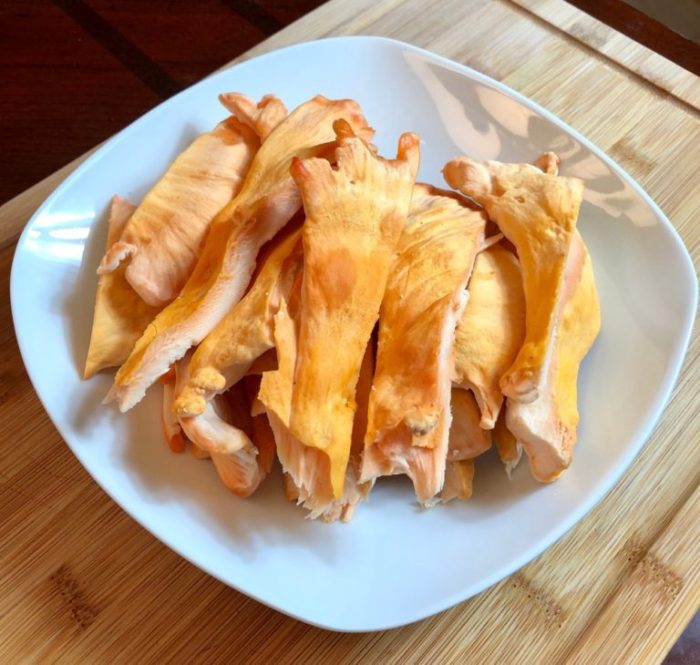Prepare to embark on a culinary adventure with our comprehensive guide to chicken of the woods recipe. This versatile mushroom, boasting a unique flavor and an array of health benefits, is ready to elevate your dishes to new heights.
Discover the secrets of identifying and foraging chicken of the woods in the wild, ensuring responsible harvesting practices. Explore a range of culinary techniques to unlock its full potential, from sautéing to roasting, and learn the art of preserving its freshness and flavor.
Culinary Applications
Chicken of the woods is a highly versatile culinary ingredient that can be incorporated into various preparations. Its meaty texture and mild flavor make it a suitable substitute for chicken in many dishes. It can be grilled, roasted, fried, or sautéed, and pairs well with various sauces, seasonings, and vegetables.
Dishes featuring Chicken of the Woods
- Grilled Chicken of the Woods: Grilled chicken of the woods is a popular dish that showcases its smoky and savory flavors. It can be served with a simple marinade or seasoned with herbs and spices.
- Roasted Chicken of the Woods: Roasting chicken of the woods brings out its nutty and earthy notes. It can be roasted with root vegetables, such as carrots and parsnips, for a hearty and flavorful meal.
- Fried Chicken of the Woods: Fried chicken of the woods is a crispy and indulgent dish that is sure to please. It can be coated in a batter or bread crumbs and fried until golden brown.
- Sautéed Chicken of the Woods: Sautéing chicken of the woods is a quick and easy way to cook it. It can be sautéed with onions, garlic, and other vegetables for a flavorful side dish or main course.
Nutritional Value

Chicken of the woods is a nutritional powerhouse, boasting an impressive array of vitamins, minerals, and antioxidants. It is an excellent source of:
- Vitamin D:Essential for bone health and immune function.
- Potassium:Supports blood pressure regulation and muscle function.
- Phosphorus:Vital for energy production and bone mineralization.
- Riboflavin (Vitamin B2):Necessary for energy metabolism and red blood cell production.
- Niacin (Vitamin B3):Plays a role in metabolism, nerve function, and skin health.
Compared to other edible mushrooms, chicken of the woods stands out for its high vitamin D content. It contains significantly more vitamin D than most commonly consumed mushrooms, making it a valuable dietary source of this essential nutrient.
Potential Health Benefits
The nutritional composition of chicken of the woods suggests several potential health benefits, including:
- Immune support:The presence of vitamin D and antioxidants may boost the immune system and protect against infections.
- Bone health:Vitamin D and phosphorus contribute to strong and healthy bones.
- Antioxidant activity:Antioxidants protect cells from damage caused by free radicals, reducing the risk of chronic diseases.
Consuming chicken of the woods as part of a balanced diet may contribute to overall well-being and reduce the risk of certain health conditions.
Identification and Foraging: Chicken Of The Woods Recipe

Identifying chicken of the woods is crucial to avoid any potential misidentification. Here’s a comprehensive guide to help you recognize this unique mushroom in the wild:
Chicken of the woods, scientifically known as Laetiporus sulphureus, is a large, bright orange fungus that is often found growing on the trunks of dead or dying hardwood trees. It has a distinctive shelf-like shape and a soft, velvety texture. The upper surface of the mushroom is typically bright orange, while the underside is covered in small, white pores.
Physical Characteristics
- Size:Chicken of the woods can range in size from a few inches to several feet across.
- Shape:It has a shelf-like shape with a wavy or lobed margin.
- Color:The upper surface is typically bright orange, while the underside is white or cream-colored.
- Texture:The flesh is soft and velvety, and it bruises easily.
Habitat
Chicken of the woods is found in a variety of habitats, including forests, woodlands, and parks. It is most commonly found growing on the trunks of dead or dying hardwood trees, such as oak, maple, and beech.
Responsible Foraging Practices
When foraging for chicken of the woods, it is important to follow responsible practices to ensure the sustainability of this valuable resource:
- Only harvest mature mushrooms:Leave the smaller ones to continue growing and reproducing.
- Cut the mushroom at the base:Do not pull it off the tree, as this can damage the mycelium.
- Be respectful of the environment:Do not trample on vegetation or disturb wildlife.
Safety Precautions
Before consuming any wild mushroom, it is important to be absolutely certain of its identification. If you are not experienced in mushroom foraging, it is best to consult with a local expert or mycologist. Some mushrooms that resemble chicken of the woods can be toxic, so it is crucial to be able to distinguish between them.
For a taste of paradise, try the chicken of the woods recipe from Maui. This recipe incorporates fresh, local ingredients to create a dish that captures the essence of the islands. The succulent fungus is marinated in a blend of tropical spices and grilled to perfection, resulting in a symphony of flavors that will transport you to a culinary paradise.
Culinary Techniques

Preparing chicken of the woods for consumption involves a few key steps to ensure its safety and maximize its flavor. Once you’ve identified and harvested the mushroom, you’ll need to clean it thoroughly to remove any dirt or debris. Cut away any tough or woody parts, and then slice the mushroom into bite-sized pieces.
Craving a unique culinary experience? Look no further than the delectable chicken of the woods recipe . This vibrant fungus boasts a savory flavor and tender texture that will tantalize your taste buds. Whether you’re a seasoned chef or a novice cook, this recipe is perfect for exploring the wonders of foraging.
Chicken of the woods is a versatile mushroom that can be cooked in various ways. One popular method is sautéing, where the mushroom is cooked in a pan with a little oil until it’s browned and tender. You can also grill chicken of the woods, which gives it a smoky flavor.
Another option is roasting, which involves baking the mushroom in the oven until it’s golden brown and slightly crispy.
Preserving and Storing, Chicken of the woods recipe
To preserve the freshness and flavor of chicken of the woods, it’s important to store it properly. Refrigerate the mushroom in an airtight container for up to a week. You can also freeze chicken of the woods for up to six months.
To freeze, slice the mushroom into pieces and place them in a freezer-safe bag or container.
Flavor Pairings
Chicken of the woods is a versatile mushroom that pairs well with various ingredients to enhance its earthy, umami flavor. Understanding its flavor profile helps in creating harmonious and delectable dishes.
The mushroom’s mild, slightly sweet flavor makes it an excellent candidate for bold seasonings and aromatic herbs. Its meaty texture can withstand robust flavors and complements hearty dishes.
Seasonings and Herbs
- Garlic and onion: These classic culinary allies add depth and savoriness to the mushroom’s flavor.
- Thyme and rosemary: These aromatic herbs impart a woodsy and herbaceous touch, complementing the mushroom’s earthy notes.
- Paprika and cumin: These warm spices bring a touch of smokiness and warmth to the dish, enhancing its savory character.
- Lemon zest or juice: A hint of citrus brightness can balance the mushroom’s richness and add a refreshing twist.
Last Point
As you delve into the world of chicken of the woods, you’ll uncover a treasure trove of culinary possibilities. Experiment with complementary ingredients to enhance its taste profile, and let the vibrant colors and textures of this extraordinary mushroom inspire your culinary creations.
Query Resolution
What is the nutritional value of chicken of the woods?
Chicken of the woods is a rich source of vitamins, minerals, and antioxidants, including vitamin D, potassium, and ergothioneine, which has been linked to potential health benefits.
How do I store chicken of the woods?
Store fresh chicken of the woods in a paper bag or wrapped in a damp paper towel in the refrigerator for up to 5 days. For longer storage, freeze it for up to 6 months.
What are some flavor pairings for chicken of the woods?
Chicken of the woods pairs well with herbs such as thyme, rosemary, and sage, and spices like paprika, garlic powder, and black pepper. It also complements earthy flavors like roasted root vegetables and wild rice.